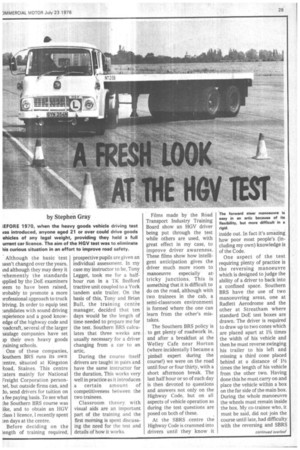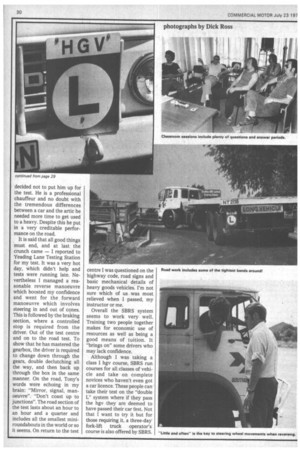by Stephen Gray
Page 31

Page 32

If you've noticed an error in this article please click here to report it so we can fix it.
1EFORE 1970, when the heavy goods vehicle driving test as introduced, anyone aged 21 or over could drive goods ehicles of any legal weight, providing they held a full urrent car licence. The aim of the HGV test was to eliminate his curious situation in an effort to improve road safety.
Although the basic test lasn't changed over the years, trid although they may deny it rehemently the standards tpplied by the DoE examiners .eern to have been raised, gobably to promote a more wofessional approach to truck (riving. In order to equip test :andidates with sound driving xperience and a good knowedge of the highway code and .oadcraft, several of the larger iaulage companies have set ip their own heavy goods raining schools.
One of these companies, 3outhem BRS runs its own .:entre, situated at Kingston .oad, Staines. This centre ..:aters mainly for National Freight Corporation person. el, but outside firms can, and Jo, send drivers for tuition on fee paying basis. To see what :he Southern BRS course was Like, and to obtain an HGV :lass 1 licence, I recently spent :en days at the centre.
Before deciding on the length of training required, prospective pupils are given an individual assessment. In my case my instructor to be, Tony Legget, took me for a halfhour run in a TK Bedford tractive unit coupled to a York tandem axle trailer. On the basis of this, Tony and Brian Bull, the training centre manager, decided that ten days would be the length of time needed to prepare me for the test. Southern BRS calculates that three weeks are usually necessary for a driver changing from a car to an artic, During the course itself drivers are taught in pairs and have the same instructor for the duration. This works very well in-practice as it introduces a certain amount of competitiveness between the two trainees.
Classroom theory with visual aids are an important part of the training and the first morning is spent discussing the need for the test and details of how it works. Films made by the Road Transport Industry Training Board show an HGV driver being put through the test while others are used, with great effect in my case, to improve driver awareness. These films show how intelligent anticipation gives the driver much more room to manoeuvre especially at tricky junctions. This is something that it is difficult to do on the road, although with two trainees in the cab, a semi-classroom environment is formed where the one can learn from the other's mistakes.
The Southern BRS policy is to get plenty -of roadwork in, and after a breakfast at the Welley Cafe near Horton (where incidentally I became a pinball expert during the course!) we were on the road until four or four thirty, with a short afternoon break. The last half hour or so of each day is then devoted to questions and answers not only on the Highway Code, but on all aspects of vehicle operation as during the test questions are posed on both of these.
At the SBRS centre the Highway Code is crammed into drivers until they know it
The forward steer manoeuvre is easy in an artic because of its flexibility, but more difficult in a rigid.
inside out. In fact it's amazing how poor most people's (including my own) knowledge is of the Code.
One aspect of the test requiring plenty of practice is the reversing manoeuvre which is designed to judge the ability of a driver to back into a confined space. Southern BRS have the use of two manoeuvring areas, one at Radlett Aerodrome and the other at Streatham where standard DoE test boxes are drawn: The driver is required to draw up to two cones which are placed apart at 11/2 times the width of his vehicle and then he must reverse swinging his trailer to his left and missing a third cone placed behind at a distance of 11/2 times the length of his vehicle from the other two. Having done this he must carry on and place the vehicle within a box on the far side of the main box. During the whole manoeuvre the wheels must remain inside the box. My co-trainee who, it must be said, did not join the course until late, had difficulty with the reversing and SBRS decided not to put him up for the test. He is a professional chauffeur and no doubt with the tremendous differences between a car and the artic he needed more time to get used to a heavy. Despite this he put in a very creditable performance on the road.
It is said that all good things must end, and at last the crunch came — I reported to Yeading Lane Testing Station for my test. It was a very hot day, which didn't help and tests were running late. Nevertheless I managed a reasonable reverse manoeuvre which boosted my confidence and went for the forward manoeuvre which involves steering in and out of cones. This is followed by the braking section, where a controlled stop is required from the driver. Out of the test centre and on to the road test. To show that he has mastered the gearbox, the driver is required to change down through the gears, double declutching all the way, and then back up through the box in the same manner. On the road, Tony's words were echoing in my brain: "Mirror, signal, manoeuvre". "Don't coast up to junctions". The road section of the test lasts about an hour to an hour and a quarter and includes all the smallest miniroundabouts in the world or so it seems. On return to the test centre I was questioned on the highway code, road signs and basic mechanical details of heavy goods vehicles. I'm not sure which of us was most relieved when I passed, my instructor or me.
Overall the SBRS system seems to work very well. Training two people together makes for economic use of resources as well as being a good means of tuition. It "brings on" some drivers who may lack confidence.
Although I was taking a class I hgv course, SBRS run courses for all classes of vehicle and take on complete novices who haven't even got a car licence. These people can take their test on the "double L" system where if they pass the hgv they are deemed to have passed their car test. Not that I want to try it but for those requiring it, a three-day fork-lift truck operator's course is also offered by SBRS.
















































































































